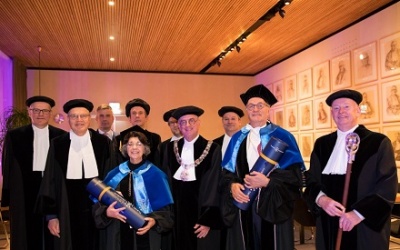Dies Natalis
Dies natalis is the Latin phrase for birthday. The University always celebrates its birthday on the third Thursday in November, which is a little odd as the academic year has already been in progress for about three months by then. As of the year 1927, the true birthday or founding date of Tilburg University has been something of a controversy. Up until 1940, dies natalis celebrations used to take place on 7 March, the date on which “the Dutch Episcopal Conference announced to the faithful entrusted to their care ‒ Salvation is of the Lord ‒ that a Roman Catholic Business School was to be established in Tilburg.”
Dies 2017, with honourary doctors
Which date?
Right from the start, the institution was unhappy about this date because it coincided with the Christian observance of Lent, and it would be unseemly to indulge in celebrations during the fasting period. And so, after more than ten years of hemming and hawing, the Curatorium, which initially refused to give in, agreed to a date change. On 10 May 1940, the day when the Second World War broke out, it announced in a letter that the dies was henceforth to be celebrated on 21 November, which is the Presentation of the Blessed Virgin Mary, the day when Mary was taken by her parents to the temple to be consecrated to God.
Celebration
For a long time, the dies program remained the same: festivities would start with Holy Mass in the Tilburg town center in the morning, followed by the dies lecture by the Rector in the Auditorium in the afternoon, then a Professors Dinner in the evening and finally a student party at night. While Holy Mass was losing most of its appeal in the seventies, the party nights were gaining more and more attraction. That was the time when, for reasons of practicality, it was decided to abandon an exact date and to choose a fixed moment: the third Thursday in November.
This seems to have been a wise decision, as there are two further dates, besides 7 March and 21 November, that might qualify as Dies Natalis. There is 29 August, the day in 1927 when the deed of the Founding Act was executed by the solicitor. And another option would have been 8 October, the day when the first academic session was held in the New Harmony building on Station Road, which is also the date that is mentioned on the beadle’s mace.

